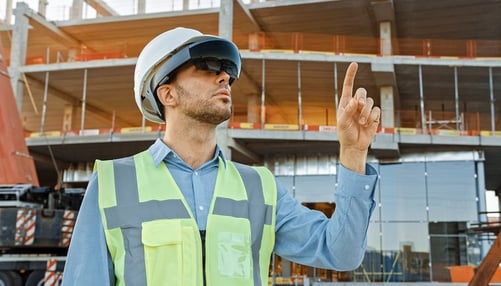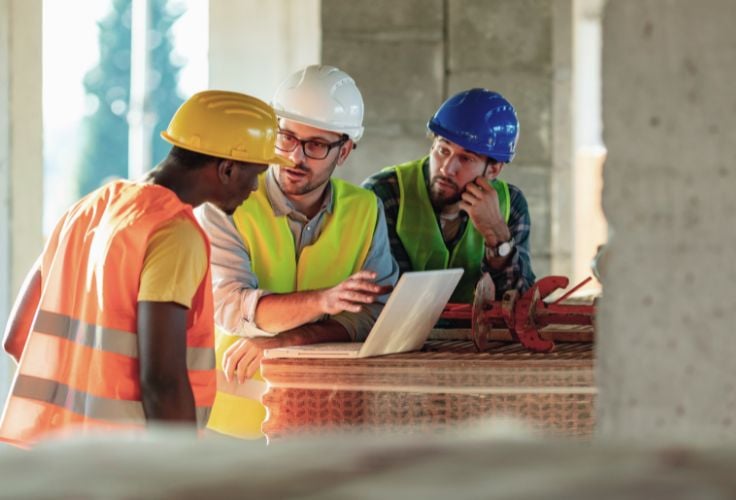Although the year started with cautious optimism that costs would continue to go down, the latest data from the U.S. Bureau of Labor Statistics show an increase in construction input prices. Specifically, "construction materials prices increased 0.4% in...
Virtual Builds, Real Efficiency: The New Era of Construction Procurement

Imagine stepping inside your next construction project before it's even built – welcome to the world of Virtual Reality in construction.
Imagine stepping onto the site of your next major commercial project before the groundwork has even begun. Welcome to the groundbreaking impact of Virtual Reality (VR) in the construction industry. VR is pioneering a revolution, transforming commercial construction processes from the initial design phase to execution, inviting professionals to immerse themselves in a digitally constructed world that enhances planning, collaboration, and project efficiency.
The Commercial VR Revolution
Say goodbye to the era of static, complex blueprints. VR brings a dynamic approach to commercial building design and project execution. Picture strapping on a headset and navigating through a commercial complex or a multifamily building unit, absorbing the spatial dynamics, and scrutinizing every aspect of the structure, long before construction commences. This transformative technology is not just impressive; it’s reshaping the very foundations of commercial construction.
Redefining Design and Planning for Efficiency
In commercial construction, the stakes are high, and precision is non-negotiable. VR technology is ushering in a new era where the majority of firms are now harnessing 3D modeling. With immersive VR, professionals can conduct a virtual walk-through of every space, ensuring every element is meticulously planned and sustainable design principles are integrated right from the start. This not only enhances the planning phase but also revolutionizes it, facilitating more strategic and accurate decisions.
Transforming Commercial Presentations and Proposals
Moving beyond flat renderings, VR allows stakeholders to fully visualize and experience commercial spaces, from high-rise office buildings to expansive retail complexes. With VR, clients are immersed in the project, gaining a tangible understanding of the scale, layout, and potential of their investment. This level of engagement is invaluable for fostering trust and making informed decisions.
Streamlining Collaboration and Material Management
Envision a global team of architects, engineers, and project managers converging in a virtual space, all brought together by VR technology. Regardless of their physical location, teams can collaborate to inspect, adapt, and refine their designs, fostering a seamless workflow. This unity is essential for maintaining a shared vision and significantly minimizing the misunderstandings that can lead to project delays and increased costs.
workflow. This unity is essential for maintaining a shared vision and significantly minimizing the misunderstandings that can lead to project delays and increased costs.
Moreover, the integration of VR into procurement and material management processes signifies a leap towards greater efficiency. By visualizing material requirements in a virtual space, project managers can streamline the ordering process, reduce excess, and ensure that the right materials are procured at the right time, reducing waste and promoting a lean construction methodology.
Enhancing On-Site Safety and Preparedness
VR's role in safety training is invaluable, especially in high-risk commercial construction environments. By simulating scenarios, workers can train for emergency responses and complex machinery operations in a risk-free setting. This proactive approach is a significant stride in enhancing on-site safety protocols.
Cost Reduction and Sustainable Practices
Identifying design discrepancies early through VR can lead to considerable cost savings and sustainability benefits in the tangible world. Implementing VR has been shown to reduce planning errors dramatically, consequently decreasing the need for physical mock-ups and preventing expensive project delays. By optimizing resource utilization and reducing rework, VR is proving to be not just a tool for innovative design but a strategic asset for cost management and environmental stewardship in commercial construction.
Conclusion
The integration of Virtual Reality in commercial construction is not simply an enhancement of existing methods; it represents a total reimagination of the construction process. It's an exciting fusion of technology and practical application, setting a new benchmark for efficiency and procurement in the industry. As we push the boundaries of what's possible, VR stands as a testament to the extraordinary progress in construction technology, positioning firms at the forefront of the commercial building sector.
Get the latest insights on materials management for modern construction jobsites.

What the increase in Material Prices means to you
by Christian Erickson | Apr 12, 2024 | Trades 101 Blog, Material procurement, Construction material management, Invoicing, Materials Procurement, Job Cost Accounting

Green Building Success: Sustainable Strategies for Construction
by Lexi Garden | Mar 14, 2024 | Trades 101 Blog, News, Material procurement, Materials Management, Construction material management, Materials Procurement, Trades Blog
In the modern construction landscape, sustainability isn't just a buzzword—it's a necessity. As the industry struggles with environmental challenges, adopting green building practices becomes necessary for long-term success. We delve into actionable...

7 Reasons Technology Drives Successful Projects
by Christian Erickson | Feb 28, 2024 | Trades 101 Blog, News, Material procurement, Materials Procurement, Trades Blog
Specialty trade contractors face unique challenges in purchasing and material management that often go beyond the capabilities of basic tools like email, text, and spreadsheets. Learn why embracing more advanced tools is essential for successful projects and...


